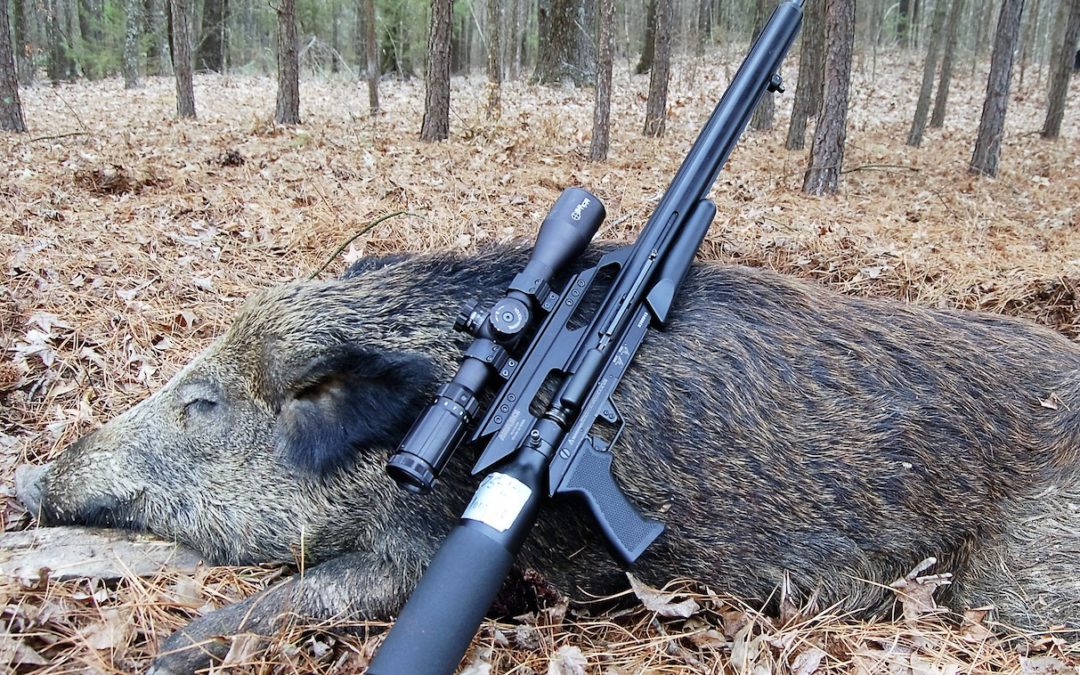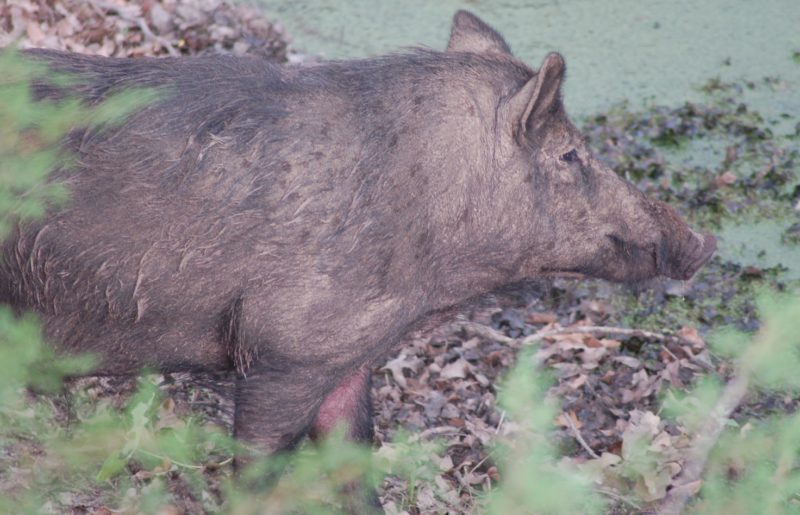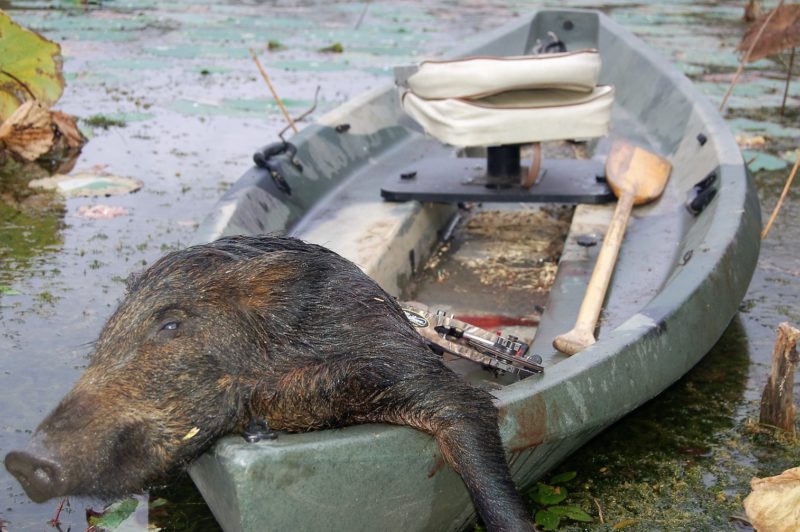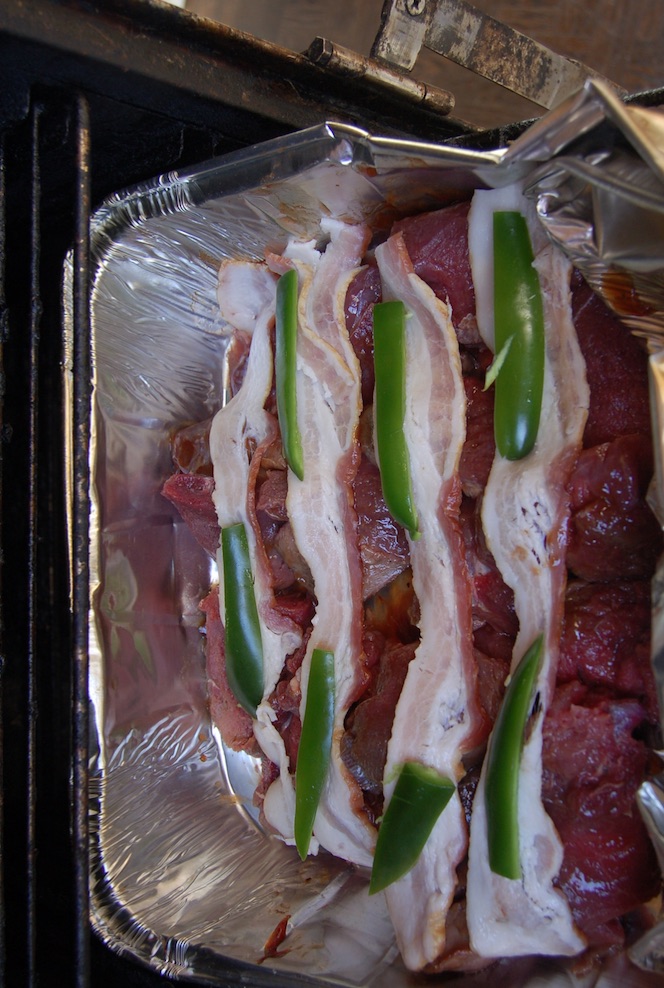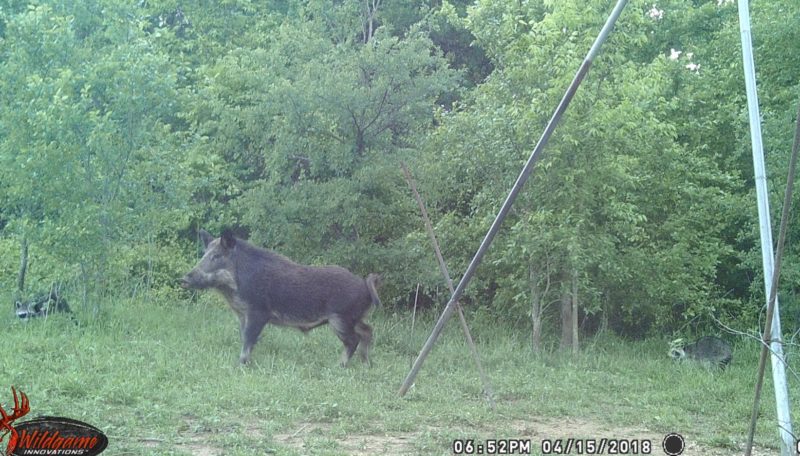Today, the lion’s share of hog hunters still come during the cold weather months, but more and more hunters have learned that hogs can be successfully hunted throughout the year. Nowadays, many outfitters offer hog hunts during the warm weather months.
Back in the eighties, Mark Balette with B&C Outfitters near Groveton, Texas was one of the first outfitters in east Texas to high fence a large tract of land and offer hog hunts.
“When I first began offering hog hunts,” says Balette, “most of my clients came either just before whitetail bow season as a tune up hunt, or after the close of deer season. But for the past few years, we have a lot of hunters coming for hogs during the heat of the summer. This period provides some great hunting.”
Most hunters spend the first three hours or so of the morning in the woods and then the last couple of hours before dark when hogs are most active. During mid-day, hunters stick around the air-conditioned lodge or do some fishing. Thanks to a walk-in cooler to keep the meat chilled, summer hunting is even more appealing.
Texas is blessed with an abundance of hunting ranches where traveling hunters can pursue their quarry using a wide variety of methods. Want to experience the thrill of following a pack of hounds hot on the trail of wild boar? Opportunities abound for such hunts in Texas!
Want to hunt with a bow, crossbow, muzzleloader, handgun, big bore air rifle, shotgun or possibly collect your pork from a helicopter or with a spear? Your hunt awaits in Texas. all that is required is for you to spend a little time on the internet checking out the opportunities and then make a few calls and quiz outfitters that suit your style of hunting.
With the advancements and availability of thermal and night vision equipment, hunting hogs after the sun sets has become extremely popular and many ranches offer night hunts, complete with the necessary equipment.
These hunts can be either spot-and-stalk or from stands. To my way of thinking, nothing is more exciting than to be watching a corn feeder on a jet-black night, listening to the creatures of the dark, occasionally using a digital or thermal monocular to scan the area around your stand, and suddenly have a big boar or “eater hog” walk into your field of view! When pressured, wild porkers have a tendency to become almost entirely nocturnal, and I’d venture a guess that at least half the wild porkers harvested today are taken at night.
Hog hunting ranches in Texas offer both free range and inside hog-proof fences on preserves. As a veteran (aka “old”) outdoors writer with a passion for hunting hogs, I’ve spent a great deal of time hunting both types of operations. On large tracts of land, free range hunting can be very good. But anyone who understands wild hogs knows that the critters can be difficult to pattern.
I had an old hog hunting guide pose a question to me years ago while discussing how to pattern the pigs. “When a wild hog wakes up from his nap, how does he decide which direction he wants to go?”
Pregnant pause.
“It all depends on which direction his nose is pointing!” he said with a chuckle.
Through the years, I’ve found hogs a bit easier to pattern that that. But the truth is, hogs often range several miles during their nightly forays to feed; usually along creeks or rivers. I hunt a 250-acre tract of land near my home on a year-around basis and keep two feeders with trail cameras running. I will sometime see a mixed sounder of hogs move in and stay for a couple of weeks and then they will simply vanish, usually replaced by a “new” bunch of hogs.
If you are hunting hogs confined under a game proof fence, you can be assured they are “there”, somewhere and not on a farm or ranch three miles down the creek where you do not have permission to hunt. If you own the land you hunt or are on a season lease, this is not a problem – you can get them next time. but if you have only a couple days to hunt, you might find yourself buying pork chops when you return home.
The wild hog is one animal that, when stocked or born inside the confines of a game fence, remains wild. In truth, “high fenced” hogs are sometime more difficult to hunt than those that are free ranging. Probably because hogs learn their area so well that they become very good at “patterning” hunters. On a big ranch with light hunting pressure, hogs can be pretty easy to pattern.
The biggest myth about hunting “fenced” hogs contained in several hundred acres of dense cover is that the hunt is “easy”. About the only advantage the hunter has on these ranches over free ranging operations is the fact that the hogs are “there.”
The hunts on most established hog hunting operations fill up early, especially during the prime cold weather months of January through mid-April. Many hunters make an annual outing to Texas, and before they leave, they make sure they are “on the books” for the upcoming year. It’s a good idea to book your hunt as early as possible.
Most established ranches have websites that do a good job of describing the details of the hunt, but nothing beats a good conversation for addressing all the questions one might have. When booking your hunt, make sure and ask about meat care, skinning and quartering, trophy fees, and food. Some ranches encourage hunters to prepare their own meals at the lodge or cabin or go to a nearby café. Other ranches offer meals.
It’s also a good idea to let the outfitter know what weapon you will be using. For instance, if you are a bow hunter who shoots left handed, inquire if he has any tree stands set up for lefties. Little things like this might sound trivial, but once the hunting begins they become very important.
When considering booking a hog hunt in a state as large and diverse as Texas, a bit of consideration should be given to the type of terrain one favors hunting. I’ve had some great hunts out in the Texas Panhandle in pretty open country, focusing on creek bottoms with timber. If you like hunting “tight” then the piney woods of the eastern part of the state are ideally suited for you.
Of course, there are tons of hogs in the Edwards Plateau Region, nicknamed the “Hill Country.” One of my favorite places to hunt free ranging hogs is in the big ranch country of North Texas, especially the “Cedar Break” country a couple hours west of Ft. Worth and south of Wichita Falls. This area provides some very rugged canyons with agricultural fields planted on the flat, high ground adjacent the rugged terrain. The thick cedar and mesquite in the canyons provide great cover with easy access to the cropland.
Texas has a smorgasbord of hog hunting opportunities available for the traveling hunter. Below is a list of a few of my favorite hunting spots but by no means is my list all inclusive. The internet can be your best friend when searching for a ranch in Texas to collect your fresh pork chops. Or better yet, check with some of your hunting buddies. It’s a good bet that if you haven’t hunted Texas, some of your friends have. Hog hunting here is just that popular!
RANGER CREEK RANCH “mini” hog leases. Situated up in the Cedar Break country of Knox County west of Seymour, Ranger Creek Ranch offers more than 12,000 acres of prime free ranch wild hog hunting. The ranch has a comfortable lodge and provides meals, guide and lodging.
Ranch owner Ranell Scott began offering “mini” leases this year. The term “mini” does not refer to the amount of land you can hunt. The hunter chooses several dates when he wishes to hunt for three or four days. The concept is catching on with hunters who don’t have time to do all the work necessary to maintain a season lease; fill corn feeders, plant food plots, maintain a camphouse, etc. In essence, when the hunter shows up, he is furnished with a cabin and stands and feeders ready to hunt.
It’s a hunting lease without all the work. For more information on hunting at Ranger Creek Ranch, visit the website www.rangercreekranch.com.
B & C OUTFITTERS is situated in east Texas near Groveton. Mark Balette’s B & C Outfitters was one of the first “high fenced” wild hog hunting operations in East Texas. I’ve enjoyed many hunts here for both hogs and exotics. With a very nice lodge that can accommodate six or so hunters, Balette’s operation is one I can highly recommend. I’ve always had multiple shot opportunities on hogs when either stand hunting or stalking. For more information, visit www.easttexasexotics.com or call Balette at 936- 544-0882.
L&L OUTFITTERS is situated near Athens, Texas, about an hour east of Dallas. They provide some really great hunting for free ranging hogs. A nice lodge is on the property and outfitter Larry Large will be on hand to make sure your hunt is a good one. Suited to comfortably accommodate up to four hunters, this is a great opportunity for small groups. For information, visit www.huntingeasttexas.com or call Large at 970-819-3464.
Texan Luke Clayton is an outdoors writer, author, and host of three radio shows. You can purchase his book, “Kill to grill, the ultimate guide to hunting and cooking wild hogs” at www.catfishradio.org.

